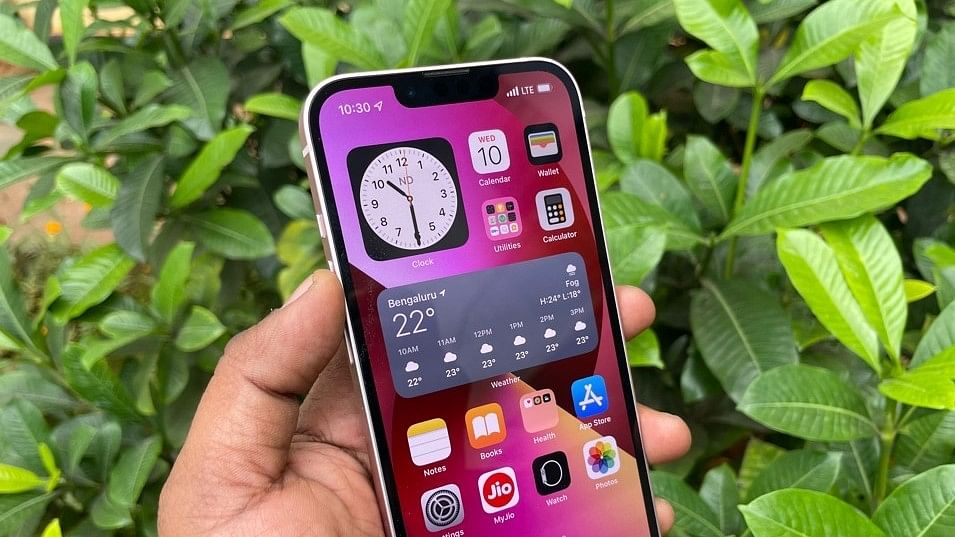
Apple iPhone 13.
Credit: DH Photo/KVN Rohit
Since the advent of the internet in the late 20th century, it has grown big and helpful than ever before. It has everything from the vast wealth of knowledge to several petabytes of movies, TV series, music, and other forms of entertainment for people to kill time. It also offers the convenience of getting work done with a few clicks of a button. However, it also has a dark side, which people should be cautious of or else risk hurting their public image and losing monetary wealth.
There is an increased number of cyber frauds online around the world including in India. While platform owners such as Google, Apple, and Microsoft are increasing security in cyberspace, people must exercise caution while shopping on e-commerce or transacting on any website.
It is also important for parents to know what their children are doing with their gadgets. Young kids and teenagers really don't know how to react to strangers online. With friendly gestures, they get bowled over and begin to blindly trust them. Elders should control what kids can view, and know who they are interacting with more on social media platforms or what kind of games they play on the devices.
Apple, a strong advocate of user privacy, has introduced several child safety features with its products. With World Safer Internet Day celebrated this week (on February 6), DH lists important safety features of Apple devices to keep yourself and your kids protected against cyber threats.
Family Sharing
This feature is the first step for guardians to control the gadget usage of kids
On the iPhone or iPad
Step 1: Go to Settings.
Step 2: Tap your name.
Step 3: Tap Family Sharing, then tap Set Up Your Family.
Step 4: Follow the onscreen instructions to set up your family and invite your family members.
On the Mac with macOS Ventura or later
Step 1: Choose the Apple menu > System Settings. Click your name, then click Family Sharing.
Step 2: Click Set Up Family.
Step 3: Follow the onscreen instructions to set up your family and invite your family members.
Screen Time feature on the iPhone and iPad.
Photo Credit: Apple
Screen Time
With this, individual users and parents get statistics on how much time people or children spend on their Apple devices.
Here's how to turn on Screen Time:
Step 1: Go to Settings > Screen Time.
Step 2: Tap Turn On Screen Time, then tap it again.
Step 3: Select This is My [device] or This is My Child's [device].
If you're the parent or guardian and setting up Screen Time on the child's device, follow the prompts until you get to Screen Time Passcode and enter a passcode. Re-enter the passcode to confirm. After you confirm your passcode you'll be asked to enter your Apple ID and password. This can be used to reset your Screen Time passcode if you forget it.
Step 4: Then, tap Content & Privacy Restrictions. If asked, enter your passcode, then turn on Content & Privacy Restrictions.
The parent can restrict the child from viewing age-inappropriate content in apps, books, TV shows, and movies. Just follow the onscreen instructions during setup.
Down Time
Step 1: Go to Settings and tap Screen Time.
Step 2: Scroll down and choose your child's name under Family.
Step 3: Tap Turn on Screen Time, then tap Continue.
Step 4: Set up Downtime, App Limits, and Content & Privacy with the limitations you want for your child, or tap Not Now.
Step 5: Tap Use Screen Time Passcode, then enter a passcode when prompted. Re-enter the passcode to confirm.
Here's how to set limits for app use for kids on Apple devices:
With this feature, users can set a time limit for a category of apps (for example, Games or Social Networking) and for individual apps.
Step 1:Go to Settings > Screen Time.
Step 2: Tap App Limits, then tap Add Limit.
Step 3: Select one or more app categories.
Step 4: To set limits for individual apps, tap the category name to see all the apps in that category, then select the apps you want to limit. If you select multiple categories or apps, the time limit you set applies to all of them.
Step 5: Tap Next at the top right, then set the amount of time allowed.
Step 6: To set an amount of time for each day, tap Customize Days, then set limits for specific days. When you finish setting limits, tap 'Add' to complete the process.
Communication Safety feature on iPhone.
Photo Credit: Apple
Here's how to set up Communication Limits on kids' Apple devices:
If the user hasn’t already turned on Contacts in iCloud, go to Settings > [your name] > iCloud, then turn on Contacts.
Step 1: Go to Settings >> Screen Time.
Step 2: Tap Communication Limits, tap During Screen Time, then select one of the following for communication at all times (other than during downtime):
--Contacts Only: To allow communication only with your contacts.
--Contacts & Groups with at Least One Contact: To allow one-on-one conversations only with people in your contacts and group conversations that include at least one person in your contacts.
--Everyone: To allow conversations with anyone, including unknown numbers.
Step 3: Tap Back at the top left, then tap During Downtime.
The option you selected in Step 2 (for During Screen Time) is already set here. You can change this setting to Specific Contacts, then choose one of the following:
--Specific Contacts: To select contacts to allow communication with during downtime.
--Everyone: To allow conversations with anyone, including unknown numbers.
If someone who’s currently blocked in the Communication Limit settings tries to call or send him/her a message, their communication won’t go through.
Block Contact on iPhone
Here's how to block age-inappropriate content
Set Content & Privacy Restrictions to have Screen Time block inappropriate content and set restrictions for iTunes Store and App Store purchases.
Step 1: Go to Settings >> Screen Time >> scroll down and Tap Content & Privacy Restrictions, then turn on Content & Privacy Restrictions.
Users can also Select options to set content allowances for iTunes Store and App Store purchases, app use, content ratings, and more.
Step 1: Go to Settings >> Screen Time>> scroll down and Tap Content & Privacy Restrictions, then turn on Content & Privacy Restrictions >> iTunes & App Store Purchases.
Sensitive content will be blocked on children's iPhone.
Photo Credit: Apple
How to prevent your child from making purchases on iTunes & App Store:
[Note: Apple iPhone should have iOS 16 or newer version to make the changes.]
Step 1: On the child's iPhone, go to Settings and tap Screen Time.
Step 2: Tap Content & Privacy Restrictions. If asked, enter your passcode.
Step 3: Tap iTunes & App Store Purchases.
Step 4: Choose a setting and set it to Don't Allow.
How to prevent your child from seeing age-inappropriate content on Apple device:
Step 1: Open Screen Time settings:
A) iPhone or iPad: Go to Settings > Screen Time.
B) Mac: Choose the Apple menu > System Settings, then click Screen Time.
Step 2: Select the name of a child in your family group.
Step 3: Select Communication Safety.
Step 4: Turn Communication Safety on or off. You might need to enter the Screen Time passcode for the device.
Once turned on, the Communication Safety feature can detect nude photos and videos in these apps and services:
Messages, AirDrop, Contact Posters in the Phone app and the Contacts app, FaceTime video messages, and when your child selects a photo or video from their photo library to use in another app, including some third-party apps.
And, Communication Safety will allow the child to leave the conversation, block the contact, leave a group message, and offer access to online safety resources. This way, it reassures the child that it’s okay if they don’t want to view the photo or video, or if they want to leave the conversation.
Private Relay
If the family is subscribed to Cloud+ service, they get additional security such as a private relay. Whenever he/she browse the web in Safari. It ensures that no single party — not even Apple — can see both who the users are and what sites they're visiting.
Users with an iCloud+ subscription can turn on Private Relay in Settings > Apple ID > iCloud > Private Relay
Screen Distance feature on iPhone.
Photo Credit: Apple
Screen Distance
As per health studies, viewing smartphone screen from close distances will have long-term vision problems. So, avoid such issues, Apple has introduced screen distance feature to ensure there is gap of 12 inches ( one feet) away from the eyes.
Step 1: Go to Settings > Screen Time.
Step 2: Tap Screen Distance, then turn Screen Distance on or off.
Get the latest news on new launches, gadget reviews, apps, cybersecurity, and more on personal technology only on DH Tech.
